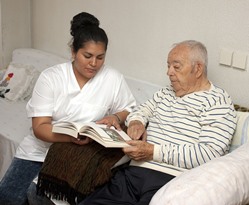How to Choose the Right LPN College near Post Texas
 There are basically two academic credentials offered that provide training to become an LPN near Post TX. The one that can be finished in the shortest period of time, commonly about twelve months, is the certificate or diploma course. The 2nd alternative is to obtain a Practical Nursing Associate Degree. These LPN programs are more comprehensive in nature than the diploma option and normally require 2 years to finish. The benefit of Associate Degrees, aside from providing a higher credential and more extensive training, are that they provide more transferable credit toward a Bachelor’s Degree in nursing. Regardless of the type of credential you seek, it should be state approved and accredited by the National League for Nursing Accrediting Commission (NLNAC) or any other national accrediting organization. The NLNAC guarantees that the core curriculum properly prepares students to become Practical Nurses, and that the majority of graduates pass the 50 state required NCLEX-PN licensing exam.
There are basically two academic credentials offered that provide training to become an LPN near Post TX. The one that can be finished in the shortest period of time, commonly about twelve months, is the certificate or diploma course. The 2nd alternative is to obtain a Practical Nursing Associate Degree. These LPN programs are more comprehensive in nature than the diploma option and normally require 2 years to finish. The benefit of Associate Degrees, aside from providing a higher credential and more extensive training, are that they provide more transferable credit toward a Bachelor’s Degree in nursing. Regardless of the type of credential you seek, it should be state approved and accredited by the National League for Nursing Accrediting Commission (NLNAC) or any other national accrediting organization. The NLNAC guarantees that the core curriculum properly prepares students to become Practical Nurses, and that the majority of graduates pass the 50 state required NCLEX-PN licensing exam.
What is an LPN?
 Licensed Practical Nurses have many different duties that they perform in the Post TX medical facilities where they work. As their titles indicate, they are mandated to be licensed in all states, including Texas. Although they may be responsible for monitoring Certified Nursing Assistants (CNA), they themselves generally work under the guidance of either an RN or a doctor. The medical facilities where they work are numerous and diverse, for example hospitals, medical clinics, schools, and long-term care facilities. Anywhere that you can encounter patients requiring medical attention is their dominion. Each state not only controls their licensing, but also what work activities an LPN can and can’t perform. So based on the state, their routine job functions might include:
Licensed Practical Nurses have many different duties that they perform in the Post TX medical facilities where they work. As their titles indicate, they are mandated to be licensed in all states, including Texas. Although they may be responsible for monitoring Certified Nursing Assistants (CNA), they themselves generally work under the guidance of either an RN or a doctor. The medical facilities where they work are numerous and diverse, for example hospitals, medical clinics, schools, and long-term care facilities. Anywhere that you can encounter patients requiring medical attention is their dominion. Each state not only controls their licensing, but also what work activities an LPN can and can’t perform. So based on the state, their routine job functions might include:
- Checking vital signs
- Giving medications
- Setting up IV drips
- Overseeing patients
- Collecting blood or urine samples
- Keeping patient records
- Helping physicians or RNs with procedures
In addition to their occupational responsibilities being governed by each state, the healthcare facilities or other Post TX healthcare providers where LPNs work can further limit their job roles within those parameters. Additionally, they can practice in various specialties of nursing, including long-term care, critical care, oncology and cardiology.
Online LPN Programs
 Attending LPN programs online is growing into a more favored way to receive instruction and earn a nursing certificate or degree in Post TX. Certain schools will require attendance on campus for part of the training, and almost all programs call for a specified number of clinical rotation hours conducted in a local healthcare center. But since the rest of the training may be accessed online, this option may be a more accommodating solution to finding the time to attend school for many students. Concerning tuition, a number of online degree programs are less costly than other on campus options. Even other expenses such as for commuting and study materials can be reduced, helping to make education more easily affordable. And many online programs are accredited by U.S. Department of Education recognized organizations. Therefore if your job and family obligations have left you with limited time to work toward your academic goals, maybe an online LPN training program will make it more convenient to fit a degree into your busy schedule.
Attending LPN programs online is growing into a more favored way to receive instruction and earn a nursing certificate or degree in Post TX. Certain schools will require attendance on campus for part of the training, and almost all programs call for a specified number of clinical rotation hours conducted in a local healthcare center. But since the rest of the training may be accessed online, this option may be a more accommodating solution to finding the time to attend school for many students. Concerning tuition, a number of online degree programs are less costly than other on campus options. Even other expenses such as for commuting and study materials can be reduced, helping to make education more easily affordable. And many online programs are accredited by U.S. Department of Education recognized organizations. Therefore if your job and family obligations have left you with limited time to work toward your academic goals, maybe an online LPN training program will make it more convenient to fit a degree into your busy schedule.
LPN Salary
According to the Bureau of Labor Statistics, the median annual wage for Licensed Practical Nurses (LPN) was $45,030 in May 2017. The median wage is the wage at which half the workers in an occupation earned more than that amount and half earned less. The lowest 10 percent earned less than $32,970, and the highest 10 percent earned more than $61,030. Most licensed practical nurses near Post TX work full time, although about 1 in 5 worked part time in 2016. Many work nights, weekends, and holidays, because medical care takes place at all hours. They may be required to work shifts of longer than 8 hours. Employment of LPNs is projected to grow 12 percent from 2016 to 2026. Job prospects should be favorable for LPNs who are willing to work in rural and medically under served areas.
Things to Ask LPN Programs
 Once you have decided on obtaining your LPN certificate, as well as if you will attend classes on campus or online, you can use the following guidelines to start narrowing down your choices. As you probably are aware, there are numerous nursing schools and colleges near Post TX as well as within Texas and throughout the United States. So it is necessary to reduce the number of schools to select from in order that you will have a manageable list. As we previously mentioned, the site of the school along with the price of tuition are most likely going to be the initial two factors that you will look at. But as we also stressed, they should not be your only qualifiers. So prior to making your ultimate choice, use the following questions to see how your pick compares to the field.
Once you have decided on obtaining your LPN certificate, as well as if you will attend classes on campus or online, you can use the following guidelines to start narrowing down your choices. As you probably are aware, there are numerous nursing schools and colleges near Post TX as well as within Texas and throughout the United States. So it is necessary to reduce the number of schools to select from in order that you will have a manageable list. As we previously mentioned, the site of the school along with the price of tuition are most likely going to be the initial two factors that you will look at. But as we also stressed, they should not be your only qualifiers. So prior to making your ultimate choice, use the following questions to see how your pick compares to the field.
- Accreditation. It’s a good idea to make sure that the certificate program in addition to the school are accredited by a U.S. Department of Education acknowledged accrediting organization. Besides helping verify that you obtain a premium education, it may assist in obtaining financial aid or student loans, which are oftentimes not offered for non-accredited schools near Post TX.
- Licensing Preparation. Licensing criteria for LPNs differ from state to state. In all states, a passing score is needed on the National Council Licensure Examination (NCLEX-PN) together with graduation from an accredited school. Many states require a certain number of clinical hours be performed, as well as the passing of additional tests. It’s essential that the school you are attending not only delivers a top-notch education, but also preps you to satisfy the minimum licensing requirements for Texas or the state where you will be working.
- Reputation. Visit online rating services to see what the evaluations are for each of the LPN schools you are looking into. Ask the accrediting organizations for their reviews too. Also, check with the Texas school licensing authority to check out if there are any complaints or compliance issues. Finally, you can call some local Post TX healthcare organizations you’re interested in working for after graduation and ask what their opinions are of the schools as well.
- Graduation and Job Placement Rates. Find out from the LPN programs you are considering what their graduation rates are as well as how long on average it takes students to finish their programs. A low graduation rate may be an indication that students were displeased with the program and dropped out. It’s also imperative that the schools have high job placement rates. A high rate will not only substantiate that the school has a favorable reputation within the Post TX medical community, but that it also has the network of contacts to help students attain employment.
- Internship Programs. The most ideal way to get experience as a Licensed Practical Nurse is to work in a clinical environment. Almost all nursing degree programs require a specific number of clinical hours be completed. A number of states have minimum clinical hour requirements for licensing as well. Check if the schools have a working relationship with nearby Post TX community hospitals, clinics or labs and assist with the placement of students in internships.
Enrolling in an LPN Program near Post TX?
If you are considering enrolling in and attending an LPN school near Post TX, you may find the following information both interesting and useful when making your final decision.
Post, Texas
The land belonged to John Bunyan Slaughter, as it was on his U Lazy S Ranch.[4] In 1906, Slaughter sold it to Charles William (C. W.) Post, the breakfast cereal manufacturer, who founded "Post City" as a utopian colonizing venture in 1907. Post devised the community as a model town.[5][6] He purchased 200,000 acres (810 km2) of ranchland and established the Double U Company to manage the town's construction. The company built trim houses and numerous structures, which included the Algerita Hotel, a gin, and a textile plant. They planted trees along every street and prohibited alcoholic beverages and brothels. The Double U Company rented and sold farms and houses to settlers. A post office began in a tent during the year of Post City's founding, being established (with the name Post) July 18, 1907, with Frank L. Curtis as first postmaster.[7] Two years later, the town had a school, a bank, and a newspaper, the Post City Post, the same name as the daily in St. Louis, Missouri. The Garza County paper today is called the Post Dispatch. The railroad reached the town in 1910. The town changed its name to "Post" when it incorporated in 1914, the year of C. W. Post's death. By then, Post had a population of 1000, 10 retail businesses, a dentist, a physician, a sanitarium, and Baptist, Methodist, and Presbyterian churches.
Postex Cotton Mills began production in 1913 with 250 employees. When the Post interests sold the business in 1945 to Ely and Walker Dry Goods Company of St. Louis, the plant was producing six million yards of cloth a year and employed 375 workers who manufactured Postex cotton sheets and Garza pillow cases. Ely and Walker sold Postex in 1955 to Burlington Industries, the world's largest textile manufacturer at that time. By 1973, the company employed 450 persons. The mill has since closed.
Oilfield service companies have been important to the economy, as have farming and ranching. In 1989, Post had two libraries, a hospital, a nursing home, an airport, the Post Dispatch (founded 1926), and 90 businesses. The population reached 3,400 in 1928, declined to 2,000 in 1940, and increased to 3,100 during the 1950s. With the development of the local oil industry, the town's population attained its highest level of 4,800 in 1964. The 1980 census showed a population of 3,864, but by 1988, the Texas Almanac reported 4,162. In 1990, the population was 3,768.
Enroll in the Right LPN School near Post TX
 Deciding on the right Licensed Practical Nurse school is perhaps the most important first step to launching a new career in the healthcare field. There are many factors that you should take into account when picking a nursing school. These aspects will be prioritized differently contingent on your existing career objectives, obligations, and financial status. As we have highlighted in this post, it is critical that you enroll in an LPN college and a certificate or degree program that are each accredited and have excellent reputations within the medical community. You originally decided to visit this website because of an interest in LPN Courses. However, by utilizing our list of qualifying questions, you will be able to create a short list of schools to select from so that you can make your ultimate selection. And with the right degree and training, combined with your hard work and ambition to succeed, you can become an LPN in Post TX.
Deciding on the right Licensed Practical Nurse school is perhaps the most important first step to launching a new career in the healthcare field. There are many factors that you should take into account when picking a nursing school. These aspects will be prioritized differently contingent on your existing career objectives, obligations, and financial status. As we have highlighted in this post, it is critical that you enroll in an LPN college and a certificate or degree program that are each accredited and have excellent reputations within the medical community. You originally decided to visit this website because of an interest in LPN Courses. However, by utilizing our list of qualifying questions, you will be able to create a short list of schools to select from so that you can make your ultimate selection. And with the right degree and training, combined with your hard work and ambition to succeed, you can become an LPN in Post TX.
More Practical Locations in Texas
